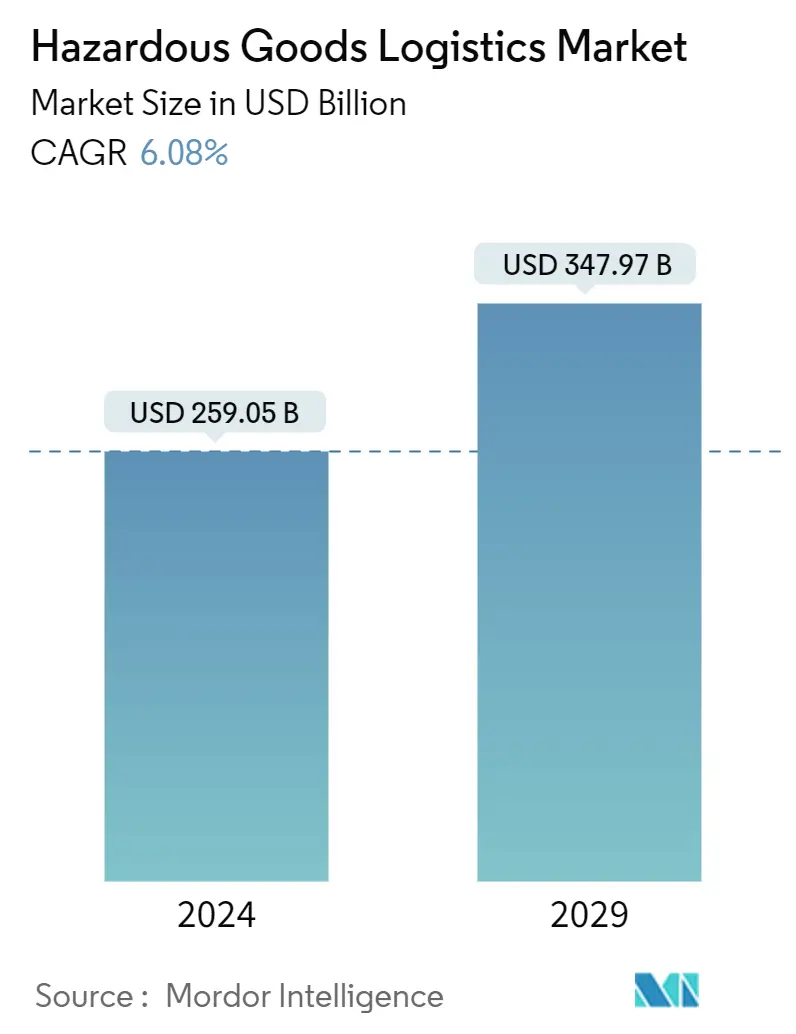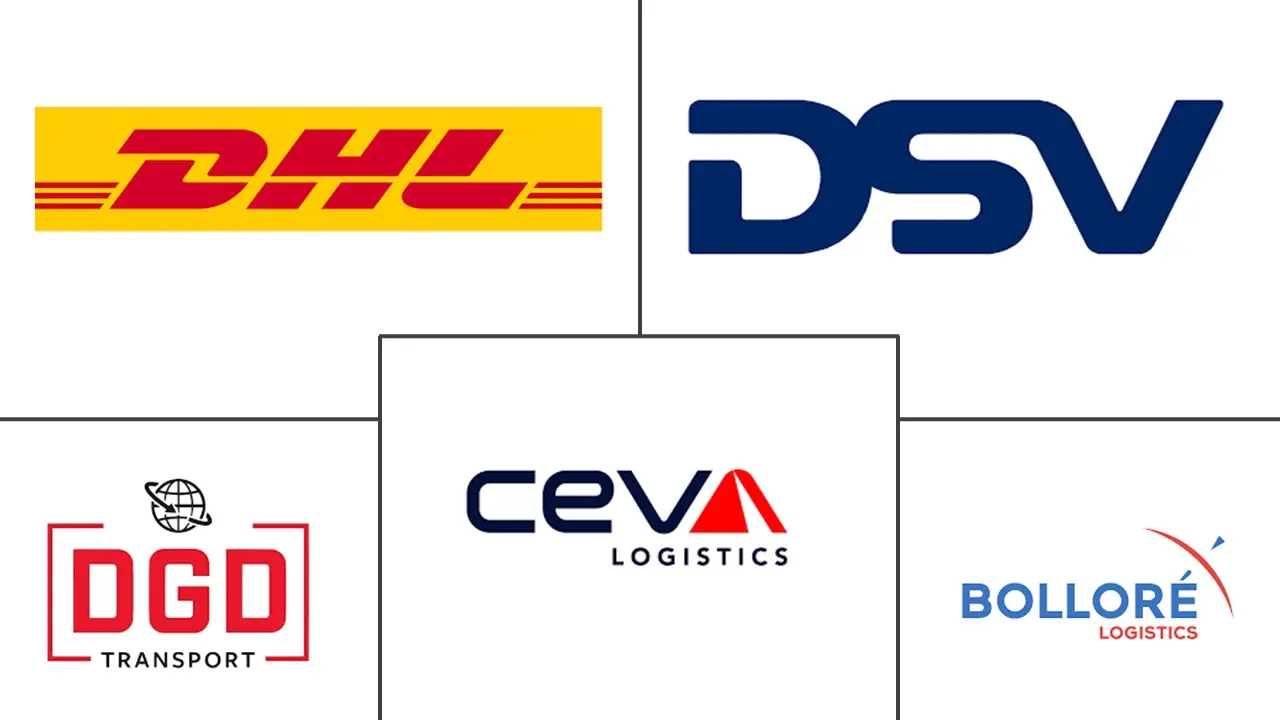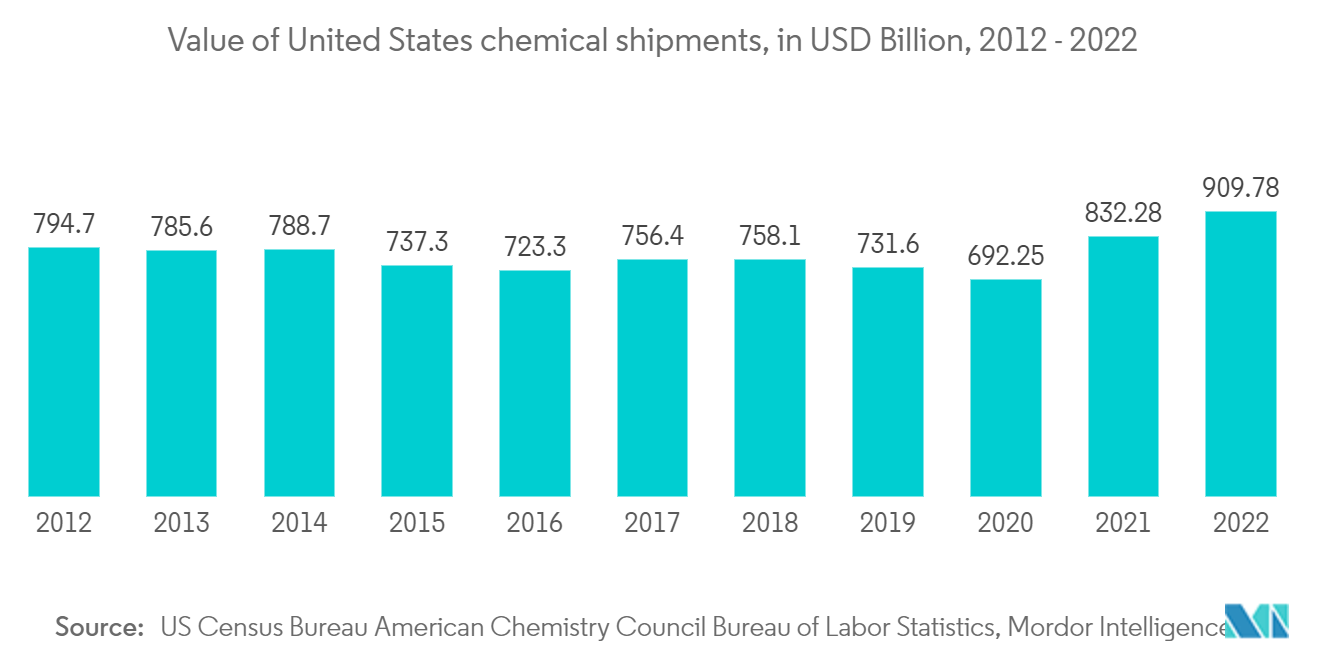Hazardous Goods Logistics Market Size

| Study Period | 2020 - 2029 |
| Market Size (2024) | USD 259.05 Billion |
| Market Size (2029) | USD 347.97 Billion |
| CAGR (2024 - 2029) | 6.08 % |
| Fastest Growing Market | Asia-Pacific |
| Largest Market | North America |
Major Players
*Disclaimer: Major Players sorted in no particular order |
Hazardous Goods Logistics Market Analysis
The Hazardous Goods Logistics Market size is estimated at USD 259.05 billion in 2024, and is expected to reach USD 347.97 billion by 2029, growing at a CAGR of 6.08% during the forecast period (2024-2029).
- Risky materials make up the bulk of international cargo, as they contain a wide range of commonly used products and items. A large portion of this cargo is said to be made up of petrol and petroleum products. Thanks to hydraulic fracturing and a government that has fostered a more conducive environment for fuel production, the current oil boom may be the result of unprecedented growth over the past few years. The United States currently produces the bulk of the world’s oil.
- The requirement to ship dangerous goods is anticipated to increase yearly, in addition to the numerous dangerous goods rules being updated annually. The need for UN packaging, training, labels, and placards will rise as a result of the growing requirement to move lithium batteries and the region's well-established gas and oil businesses, which are both driving the dangerous goods market to record highs.
- Deregulation of environmental regulations and the loosening of numerous rules restricting access to sensitive habitats and emissions has led to a boom in the oil and gas industry. Offshore drilling has also increased in our country. The US currently exports more gas than it imports, and production of gas is expected to grow in the coming year. The oil and gas market is expected to continue to grow as the US increases its external oil and gas exports.
- Additionally, all forms of transportation must be used to convey radioactive medication, virus samples, healthcare hazardous chemicals, and clinical waste such as surgical equipment. The oil and gas industry, for example, might have an impact on this expected expansion in the globe of dangerous goods. The oil and gas sector, which is still lucrative, is anticipated to receive investments totaling 237 billion dollars over the next ten years, or 25% of the entire estimated worldwide investment in this sector.
- The key to successfully transporting hazardous goods is digitization. A digital supply network serves as a technology platform for supply chain linkages and cross-business processes in transportation operations. It links suppliers, customers, shippers, and third-party logistics providers so they can work together more effectively and conduct business. Automated systems translate paper or email into the proper forms so that the document can be shared electronically with other people. This includes manual operations like completing a purchase order, recognizing the receipt of the order, and shipping confirmation.
- The lockdown during the COVID-19 pandemic created impediments to transporting chemicals and other dangerous goods, thereby hampering the growth of the hazardous goods logistics market. However, the demand from the pharmaceutical sector during COVID-19 had a positive impact on the market.
Hazardous Goods Logistics Market Trends
Increase in shipment of flammable liquids driving the market
The most widely used service category by far is transportation logistics, which is estimated to be worth 123.08 billion USD in 2022. The Medical, Nuclear Power, Oil and Gas, and Petrochemical industries are just some examples of the widespread use of hazardous materials in developing or developed economies.
Transport companies transporting dangerous goods must follow standard procedures for the safety of their vehicles and vessels. Other federal agencies regulations on dangerous products, workplace safety and environmental protection also apply.
Over the next few years, the market for hazardous products logistics will benefit significantly from Increasingly strict government regulations. The US Department of Transportation’s (DOT) Pipeline and Hazardous Materials Safety Administration (PHMSA) is responsible for the development and implementation of national regulations for the safe transport of dangerous goods. When transporting dangerous goods to, from, or within the U.S., it is critical to comply with the Hazardous Materials Regulations (HMR 49, Part 100-185).
The UN Model Regulations for the carriage of dangerous goods serve as a reference for the development of standardized regulations for all modes of transport. There is a new edition every two years. In order to facilitate trade and facilitate the safe and efficient transportation of dangerous products, labels or marks specifically designed for the carriage of dangerous commodities on cargo vessels must be applied to the dangerous goods. More importantly, they help make transportation safer.

Asia-Pacific region dominating the market
The Asia-Pacific dangerous/hazardous goods logistics market is estimated to be worth USD 70.08 billion in 2022, with China accounting for more than 52% of the global market. Due to the dramatic shift in oil consumption from the United States to other parts of the world, the global demand for oil has increased.
Large-scale petrochemical development has decreased the demand for gasoline. As a result, more dangerous goods, such as oil and gas, are being transported across the country using trucking services.
The US is projected to become the largest oil producer in the world within the next 5 years, overtaking both Saudi Arabia and Russia. Shipping companies are essential for the oil & gas industry to get their goods to customers around the world. These market trends should lead to an expansion of the hazardous goods logistics market. Hazardous materials should be packaged in accordance with applicable laws and regulations. It is also important to use labels or other identifying indicators on cargo carriers when transporting hazardous materials. This would greatly enhance transit security.
Hazardous waste includes toxic, chemical, and flammable materials. Chemically reactive components release toxic vapors when they come into contact with other components. Due to their high environmental impact, hazardous waste must be properly disposed of. In 2019, the U.S. EPA reported that 34.9 million metric tons of hazardous waste were produced by 23 700 companies and generators in the United States. Industrialization is leading to an increase in waste generation.

Hazardous Goods Logistics Industry Overview
The hazardous goods logistics market is fragmented by nature, with a mix of global and local players. Some of the strong players include DHL, DSV, Ceva Logistics, Bollore Logistics, and DGD Transport. Contracts, collaborations, joint ventures, and partnerships are among many other strategies that these players have implemented to stay ahead of the competition and meet the expanding needs of their clients.
Furthermore, they are engaging in research and development operations to strengthen their portfolios and gain market share. The capabilities of local players in terms of technology, items handled, service offered, and inventory management are all improving. With the tightening of hazardous goods logistics regulations, an increasing number of freight forwarding businesses have emerged that can provide competent hazardous goods logistics full-chain services independently.
Hazardous Goods Logistics Market Leaders
-
DHL
-
DSV
-
Ceva Logistics
-
Bollore Logistics
-
DGD Transport
*Disclaimer: Major Players sorted in no particular order

Hazardous Goods Logistics Market News
September 2023: BlackBerry Limited revealed that it is introducing the H2M IS line of BlackBerry Radar® devices, which are intended for carriers of hazardous materials. An 'Intrinsically Safe' certification designation supports the new series, allowing BlackBerry Radar, an asset tracking solution, to target logistics and transportation industries that move hazardous goods, such as railroads, fuel haulers, tank carriers, and ocean shipping lines.
June 2023: Transport Canada has granted Drone Delivery Canada Corp (DDC) authorization to conduct Beyond Visual Line-of-Sight (BVLOS) flights in conjunction with the conveyance of hazardous materials for its Care by Air drone route. According to DDC, this is a critical turning point in the growth of its drone delivery capabilities inside the healthcare industry. Deliver Canada authorizes DDC to deliver Class 7 dangerous items via BVLOS flights over the Golden Horseshoe and Southern Ontario region.
May 2023: One of the biggest express delivery firms in the world, FedEx Express, a division of FedEx Corp., just introduced its one-stop-shop logistics solutions for risky items for local businesses in Cebu. More than 2,200 different harmful commodities, ranging in class from 1 to 9, including paints, fragrances, bleach, and electronic equipment with lithium batteries, can now be shipped more easily to foreign markets.
Hazardous Goods Logistics Market Report - Table of Contents
1. INTRODUCTION
- 1.1 Market Definition and Scope
- 1.2 Study Assumptions
2. RESEARCH METHODOLOGY
3. EXECUTIVE SUMMARY
4. MARKET INSIGHTS
- 4.1 Current Market Scenario
- 4.2 Industry Value Chain Analysis
- 4.3 Government Regulations and Initiatives
- 4.4 Brief on Dangerous Goods Classes
- 4.5 Review and Commentary on Goods Transport Regulations and Standards (Hazardous Materials Transportation Act (HMTA), International Air Transport Association Dangerous Goods Regulations (IATA DGR), etc.
- 4.6 Focus on Key Stakeholders in Supply Chain (Freight Forwarders, Ground Handling Agents, Carriers, Advisors and Consultants, etc.)
- 4.7 Key Information - Documentation, Special Permissions, and Safety Checklists
- 4.8 Spotlight - Equipment and Accessories Associated with Transport of Dangerous Goods (Air, Sea, and Road)
- 4.9 Potential Risk Involved in Shipment of Hazardous Materials
- 4.10 Insights on Packaging
- 4.11 Technology Snapshot (Digitalization and Process Optimization and Management Software, e-Dangerous Goods Declaration (eDGD), etc.)
- 4.12 Impact of COVID-19 and Geopolitical Events on the Market
5. MARKET DYNAMICS
- 5.1 Drivers
- 5.2 Restraints
- 5.3 Opportunities
-
5.4 Industry Attractiveness - Porter's Five Forces Analysis
- 5.4.1 Bargaining Power of Suppliers
- 5.4.2 Bargaining Power of Buyers/Consumers
- 5.4.3 Threat of New Entrants
- 5.4.4 Threat of Substitute Products
- 5.4.5 Intensity of Competitive Rivalry
6. MARKET SEGMENTATION
-
6.1 By Service
- 6.1.1 Transportation
- 6.1.2 Warehousing and Distribution
- 6.1.3 Value-added Services
-
6.2 By Destination
- 6.2.1 Domestic
- 6.2.2 International
7. COMPETITIVE LANDSCAPE
- 7.1 Market Concentration Overview
-
7.2 Company Profiles
- 7.2.1 Deutsche Post DHL Group
- 7.2.2 DSV
- 7.2.3 Ceva Logistics
- 7.2.4 Bollore Logistics
- 7.2.5 DGD Transport
- 7.2.6 Toll Group
- 7.2.7 YRC Worldwide Inc.
- 7.2.8 DB Schenker
- 7.2.9 Hellmann Worldwide Logistics
- 7.2.10 Agility Logistics
- 7.2.11 Kuehne + Nagel
- 7.2.12 XPO Logistics
- 7.2.13 United Parcel Service
- 7.2.14 GEODIS
- 7.2.15 Rhenus Logistics
- *List Not Exhaustive
- 7.3 7.3 Other Companies (Key Information/Overview)
8. FUTURE OF THE MARKET
9. APPENDIX
** Subject To AvailablityHazardous Goods Logistics Industry Segmentation
Corrosive, flammable, explosive, spontaneously combustible, poisonous, oxidizing or water-reactive compounds are classified as hazardous goods. Logistics refers to the overall process of managing how resources are acquired, stored, and transported to their final destination.
The hazardous goods logistics market is segmented by service (transportation, warehousing and distribution, value-added services), by destination (domestic and international), and by geography (Asia-Pacific, North America, Europe, Latin America, Middle East, and Africa).
The report offers market size and forecasts for the hazardous goods logistics market in value (USD) for all the above segments.
| By Service | Transportation |
| Warehousing and Distribution | |
| Value-added Services | |
| By Destination | Domestic |
| International |
Hazardous Goods Logistics Market Research FAQs
How big is the Hazardous Goods Logistics Market?
The Hazardous Goods Logistics Market size is expected to reach USD 259.05 billion in 2024 and grow at a CAGR of 6.08% to reach USD 347.97 billion by 2029.
What is the current Hazardous Goods Logistics Market size?
In 2024, the Hazardous Goods Logistics Market size is expected to reach USD 259.05 billion.
Who are the key players in Hazardous Goods Logistics Market?
DHL, DSV, Ceva Logistics, Bollore Logistics and DGD Transport are the major companies operating in the Hazardous Goods Logistics Market.
Which is the fastest growing region in Hazardous Goods Logistics Market?
Asia-Pacific is estimated to grow at the highest CAGR over the forecast period (2024-2029).
Which region has the biggest share in Hazardous Goods Logistics Market?
In 2024, the North America accounts for the largest market share in Hazardous Goods Logistics Market.
What years does this Hazardous Goods Logistics Market cover, and what was the market size in 2023?
In 2023, the Hazardous Goods Logistics Market size was estimated at USD 243.30 billion. The report covers the Hazardous Goods Logistics Market historical market size for years: 2020, 2021, 2022 and 2023. The report also forecasts the Hazardous Goods Logistics Market size for years: 2024, 2025, 2026, 2027, 2028 and 2029.
Hazardous Goods Logistics Industry Report
Statistics for the 2024 Hazardous Goods Logistics market share, size and revenue growth rate, created by Mordor Intelligence™ Industry Reports. Hazardous Goods Logistics analysis includes a market forecast outlook to 2029 and historical overview. Get a sample of this industry analysis as a free report PDF download.



